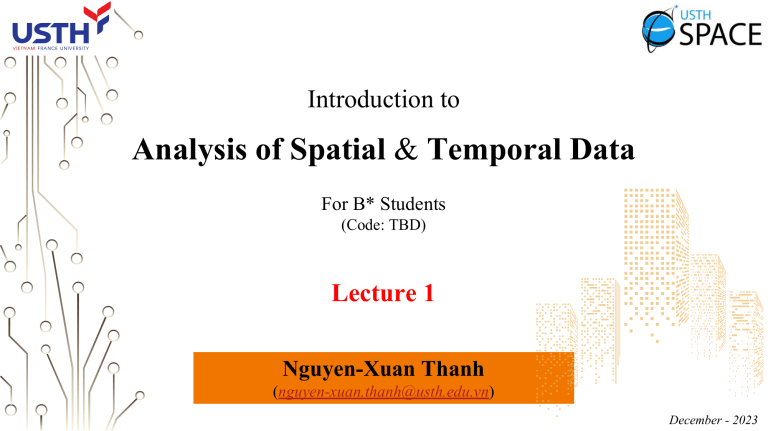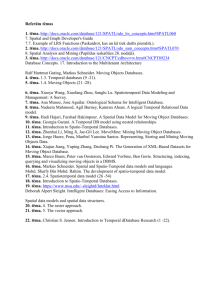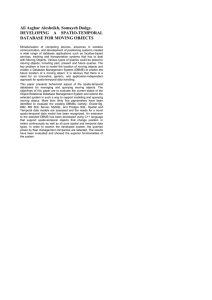
Introduction to Analysis of Spatial & Temporal Data For B* Students (Code: TBD) Lecture 1 Nguyen-Xuan Thanh (nguyen-xuan.thanh@usth.edu.vn) December - 2023 Introduction Personal Information Personal Home Page http://remosat.usth.edu.vn/~thanhnx/ •Full name: NGUYEN XUAN THANH •PhD in: Environmental Science, Policy and Management The Hong Kong University of Science and Techonology (HKUST) •Email: nguyen-xuan.thanh@usth.edu.vn nxthanhnx@gmail.com •Mobile: +84 (0) 375 713 523 2 References ❖ The main contents are modified based on: ❖ R. S. Bivand et al. Applied Spatial Data Analysis with R. [https://link.springer.com/book/10.1007/978-1-4614-7618-4] 2nd edition. Springer 2013.Book 2, Elsevier 2000 ❖ S. Banerjee, B. P. Carlin, and A. E. Gelfand. Hierarchical Modeling and Analysis for Spatial Data. [https://www.taylorfrancis.com/books/mono/10.1201/9780203487808/hierarchical-m odeling-analysis-spatial-data-sudipto-banerjee-bradley-carlin-alan-gelfand-sudipto-ba nerjee] ❖ Other(s): TBD after the first class 3 4 Objectives 1. Understand the basic knowledge of spatial and temporal data 2. To answer questions: How to extract the information, distribution and trend of objects from spatial-temporal data? 3. To answer questions: What are the popular models using in spatial and temporal analysis? What are the applications of these models for monitoring environment and earth sciences and how to manipulate the models in 4. R? To answer questions: How to evaluate the spatio-temporal statistical models using referent data? 5 Time Commitment Component Attendance Lecture 20 hours Tutorial/Exercises ? Practical/Labwork 16 hours Total 36 hours ❖ 12 classes in total ❖ 2 classes per week for 6 weeks (19/12/2023 – 26/02/2024) ❖ Personal computers are more welcome 6 Assessment Scheme & Course Policies Component Attendance Percentage (%) 10 (10) Exercise Practical Reports Mid-term Final Exam 10 (20) 0 30 (20) 50 ❖ Students can contact to the instructor in case of any concern or problem via email address and/or mobile phone: nguyen-xuan.thanh@usth.edu.vn ; +84 (0) 375 713 523 ❖ Respect yourself and the others ❖ Honesty ❖ On time (15-min rule) ❖ 4 absences without justification no final exam, no retake 7 Assessment Scheme & Course Policies Component Attendance Exercise Practical Reports Mid-term Final Exam Percentage (%) 10 20 20 0 0 50 ❖ Exercise & Practical: Problem Sets: Solved by using R Rstudio or VS Code is highly recommended Read & Summary Paper ❖ Final Exam: TBD 8 Main Contents Chapter & Contents Contents Lecture hours Practice hours Chapter 1 Introduction − − − − Types of data, geographic data Structure of geo-referenced vector data and raster data Collection of temporal and spatial data. Preparation of data 2 1 Chapter 2 Time series − Classification, components, decomposition of time series stationarity, 3 1 Parametric approach Linear Regression Non-Parametric approach – Turning Point test, Man-Kendall Test, Pre Whitened Mann Kendall test, Theil and Sen’s Median Slope 3 3 Chapter 3 − Analysis for trend − detection and − slope estimation concept of 9 Main Contents Chapter & Contents Contents Lecture hours Practice hours Chapter 4 Point processes frequency analysis − − − − − − Poisson processes Second-order interactions Spectral analysis Time-frequency analysis Non-negative matrix factorization Spatio-temporal point processes 4 3 Chapter 5 Analysis of geo-reference multi-spectral data − − − Extracting spatial distribution of objects in multi-spectral data Un-supervised classification (Isodata, K-means) Supervised classification (Parallelepiped, Minimum distance, Maximum likelihood, Spectral angle mapper) Practice to extract information from panchromatic satellite images Practice to extract information from multi-hyper spectral satellite images 4 5 Chapter 6 Spatio-temporal models and its applications − − − Kriging for spatio-temporal data Dynamic Autoregressive Spatio-Temporal Models Hierarchical models for spatio-temporal data to predict future distribution of natural phenomena. Model evaluation: Root Mean Square Error. Practice to predict the future changes of land cover from multi temporal satellite images 4 3 − − − − 10 Assessment Scheme & Course Policies Component Attendance Percentage (%) 10 (10) Exercise Practical Reports Mid-term Final Exam 10 (20) 0 30 (20) 50 ❖ Students can contact to the instructor in case of any concern or problem via email address and/or mobile phone: nguyen-xuan.thanh@usth.edu.vn ; +84 (0) 375 713 523 ❖ Respect yourself and the others ❖ Honesty ❖ On time (15-min rule) ❖ 4 absences without justification no final exam, no retake 11 Warm Up! 1. https://posit.co/download/rstudio-desktop/ 2. https://www.w3schools.com/r/default.asp 3. https://www.r-project.org




